This blog post Top 10 Must-Visit Famous Places in Ayodhya invites you on a virtual pilgrimage to Ayodhya and explores the iconic temples, serene ghats and historical sites of Ayodhya.
From the majestic Ram Janmabhoomi Temple to the serene banks of the Saryu River, Ayodhya offers a glimpse into the rich cultural heritage of India.
Renowned as the birthplace of Lord Rama, the revered deity of the Ramayana epic, Ayodhya offers a spiritual experience that transcends time.
This vibrant city is a treasure trove of ancient temples, mystical ghats, and hidden historical gems waiting to be discovered. So, put on your explorer’s hat and join me on a journey through the famous and not-so-famous places that make Ayodhya a destination etched in the soul.
A City of History and Mythology: Famous Places in Ayodhya
Ayodhya, a city in Uttar Pradesh, India, holds immense significance for both Hindus and Buddhists.
Renowned as the birthplace of Lord Rama, the seventh avatar of Vishnu according to the epic Ramayana, Ayodhya is one of the seven sacred pilgrimage sites for Hindus.
Ayodhya’s history stretches back centuries, witnessing the rise and fall of various empires.
During the Vedic period, it was the capital of the Kosala kingdom, flourishing under the reign of King Dasharatha, Rama’s father.
The city was described as prosperous and well-defended in the Ramayana.
Buddhism also left its mark on Ayodhya.
Scholars believe Ayodhya is the same as Saketa, where the Buddha is said to have resided for a while.
Evidence of this influence can be found in the numerous monasteries built during the 5th and 6th centuries BCE.
The city continued to be a prominent center throughout history, witnessing the rule of the Kanauj kingdom, the Delhi Sultanate, and the Mughal Empire.
Notably, the Babri Masjid, built by the Mughal emperor Babur in the 16th century, stood on the site believed to be Lord Rama’s birthplace.
This mosque became a contentious issue in the 20th century, culminating in its demolition in 1992 by Hindu nationalists.
The Supreme Court of India eventually ruled in favor of a Ram temple being built on the site, while granting a separate location for a mosque.
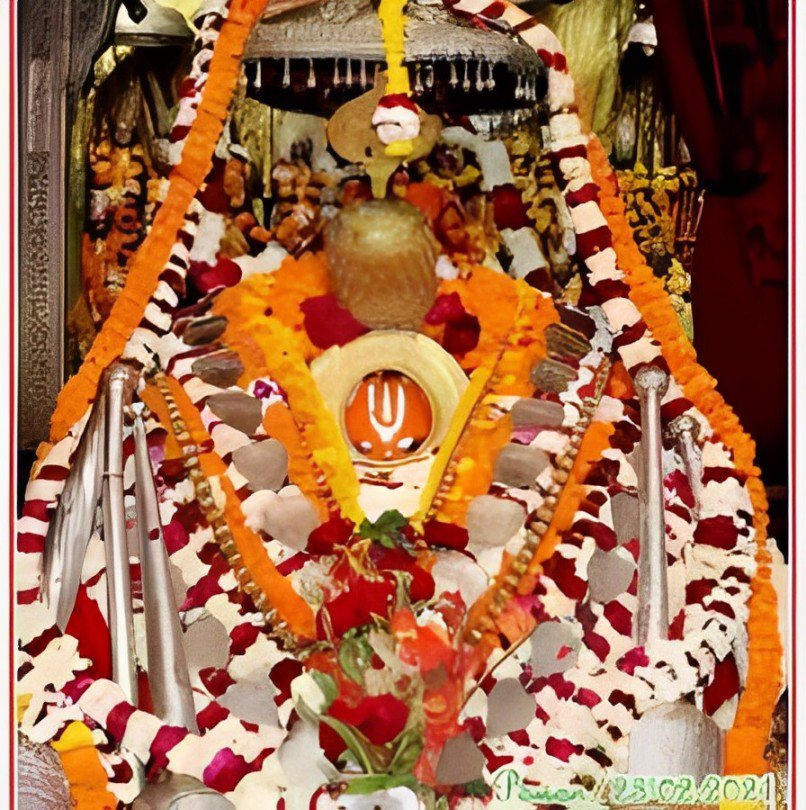
Source: Facebook
Exploring Ayodhya’s Spiritual Sites: Famous Places in Ayodhya:
Ayodhya is a treasure trove of sacred sites for Hindus. The Ram Janmabhoomi, marking the birthplace of Lord Rama, is currently under construction for a grand temple. Hanuman Garhi, dedicated to Lord Rama’s loyal devotee Hanuman, is another popular pilgrimage destination.
It features a unique cave temple with an idol of infant Hanuman resting in his mother’s lap.
Other notable sites include the Treta Ke Thakur Temple, believed to be established by Rama’s son, and the Kanak Bhawan, a palace showcasing the architectural influences of various eras.
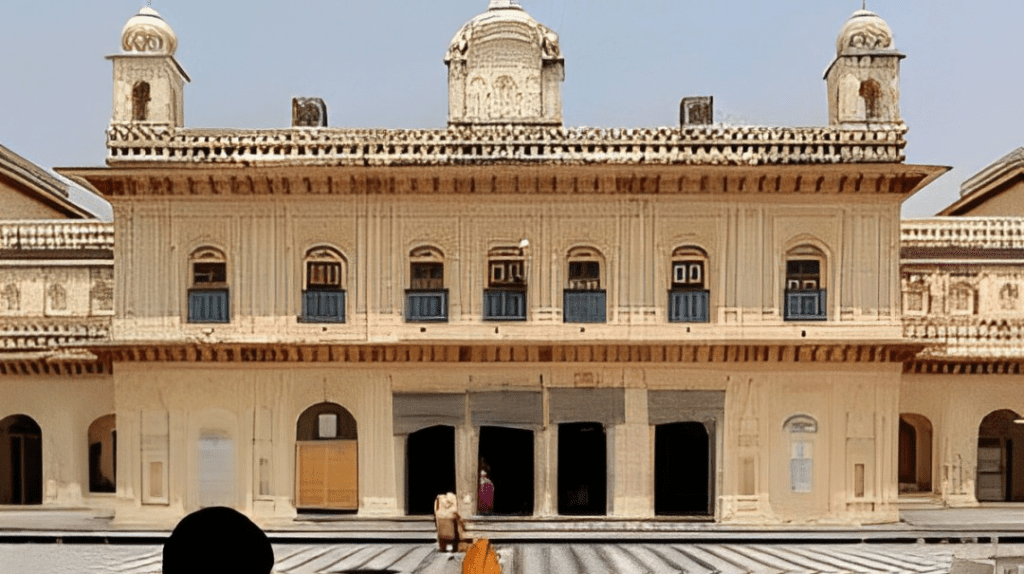
Source: Planet
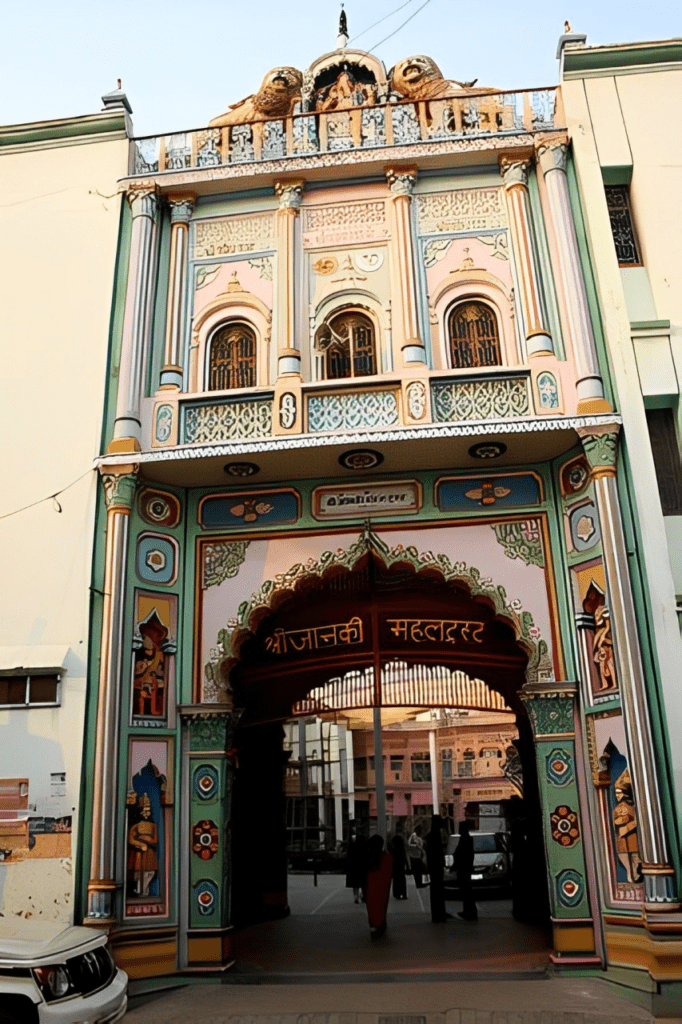
A City of Significance: Famous Places in Ayodhya:
Ayodhya’s significance transcends religious boundaries. It stands as a testament to India’s rich history and cultural tapestry, where diverse faiths and traditions have intertwined over millennia.
The city continues to be a pilgrimage destination for millions, attracting devotees and tourists alike.
Ram Janmabhoomi and Ram Mandir: Famous Places in Ayodhya
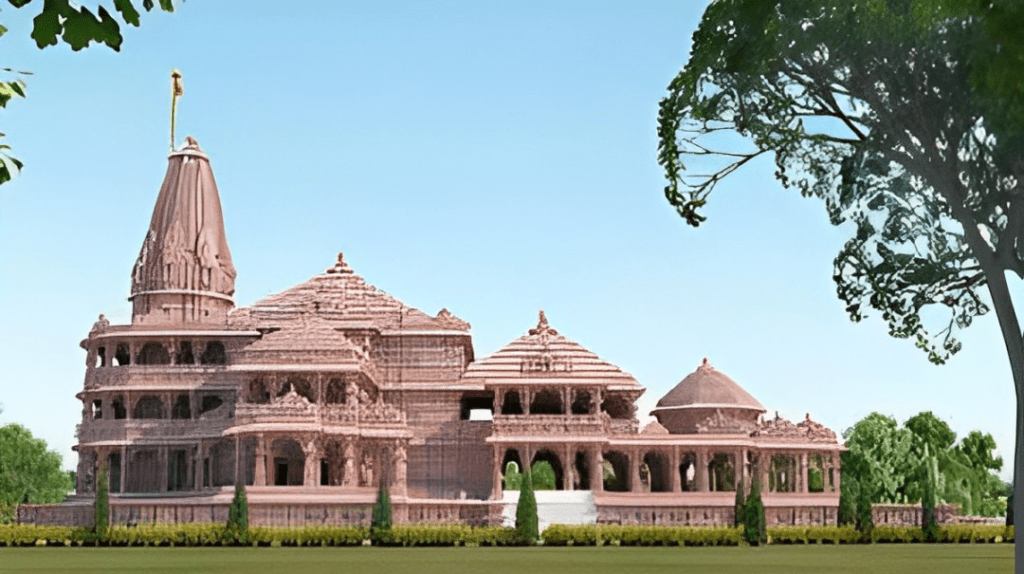
The heart and soul of Ayodhya, the Ram Janmabhoomi – the disputed site believed to be Lord Rama’s birthplace – is currently undergoing the majestic transformation into the Ram Mandir.
Its grandeur, rising on the banks of the Saryu, promises to be a pilgrimage magnet, drawing devotees from across the globe.
Hanuman Garhi: Famous Places in Ayodhya
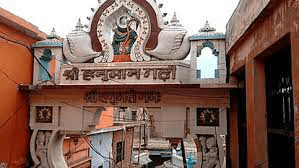
Source: Amar-Ujala
Towering over Ayodhya, Hanuman Garhi isn’t just a temple; it’s a testament to the unwavering devotion of Lord Hanuman, the monkey god revered for his loyalty and strength.
Located near the districts of Ayodhya and Faizabad, it’s considered the city’s most popular temple, attracting countless devotees throughout the year.
The journey to the inner sanctum begins with a climb up 76 stairs, each step leading you closer to the ornate entrance.
As you step inside, the first sight that greets you is a captivating idol of Anjana Devi, Lord Hanuman’s mother, gently cradling the infant Hanuman in her lap.
This captivating image embodies the tenderness and care that lies at the heart of Hanuman’s devotion.
Interestingly, the temple’s exterior resembles a four-sided fort, with sturdy circular bastions guarding each corner. This unique architectural style adds to the mystique of the place, hinting at the temple’s potential role as a protector.
While the exact origins of the temple remain unclear, some locals believe it was built in the 10th century with the blessings of the Nawab of Avadh.
Beyond its architectural and historical significance, Hanuman Garhi is renowned for the blessings it bestows. The idol of “Bal Hanuman,” the young Hanuman, is said to shower boons upon his devotees who seek his guidance and strength.
This belief draws in countless pilgrims, each offering prayers and seeking the blessings of the mighty monkey god.
Whether you’re a devout Hindu seeking spiritual solace or a curious traveler exploring the rich tapestry of Ayodhya, Hanuman Garhi stands as a must-visit destination.
Its unique blend of history, devotion, and architectural wonder is sure to leave a lasting impression.
Perched atop a hillock, Hanuman Garhi is dedicated to Lord Rama’s loyal monkey devotee. Legends narrate Hanuman’s leap of faith from here to Lanka, leaving behind a giant footprint as a testament to his devotion.
The climb to the temple, lined with vibrant monkeys, is an experience in itself.
Nageshwar Nath Temple: Famous Places in Ayodhya
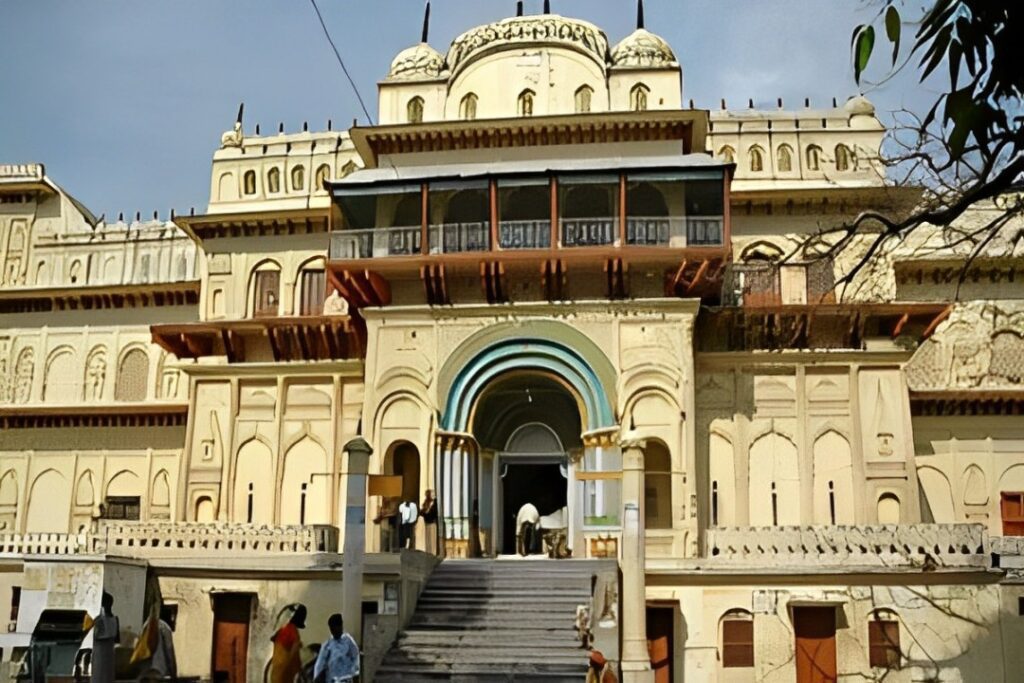
Standing tall amidst the bustling streets of Ayodhya, the Nageshwar Nath Temple is a haven for devotees of Lord Shiva. Steeped in history and legend, this sacred site boasts a unique origin story and serves as a testament to the enduring power of faith.
Legend attributes the temple’s creation to Lord Rama’s son, Kush. As the story goes, while bathing in the nearby Sarayu River, Kush lost his precious armlet.
It was then retrieved by a Naga Kanya, a serpent maiden who was also a devoted follower of Lord Shiva. Upon discovering her love for him, Kush, touched by her devotion, decided to build a temple dedicated to Lord Shiva.
Though the exact date of the temple’s origin remains unclear, historical accounts suggest it has been a place of worship since at least 750 AD.
The current structure, however, owes its form to Naval Rai, a minister under Safdarjung, who undertook its reconstruction in 1750.
Today, the Nageshwarnath Temple draws devotees throughout the year, particularly during significant festivals like Mahashivaratri and Trayodashi, also known as Pradosh Vrat.
These occasions witness grand celebrations, with the “Shiva Barat,” a procession honoring Lord Shiva, being a major highlight.
A visit to the Nageshwarnath Temple is not just a religious experience; it’s a journey into the heart of Ayodhya’s rich heritage.
The temple stands as a symbol of the city’s vibrant culture, where faith and folklore intertwine to create a tapestry of spiritual significance.
One of the oldest Shiva temples in Ayodhya, Nageshwarnath Temple boasts a fascinating tale. Legend has it that Ravana, the demon king, attempted to kidnap Sita at this very spot, but Lord Shiva intervened.
The temple’s ancient architecture and tranquil atmosphere invite introspection and spiritual connection.
Kanak Bhawan: Famous Places in Ayodhya
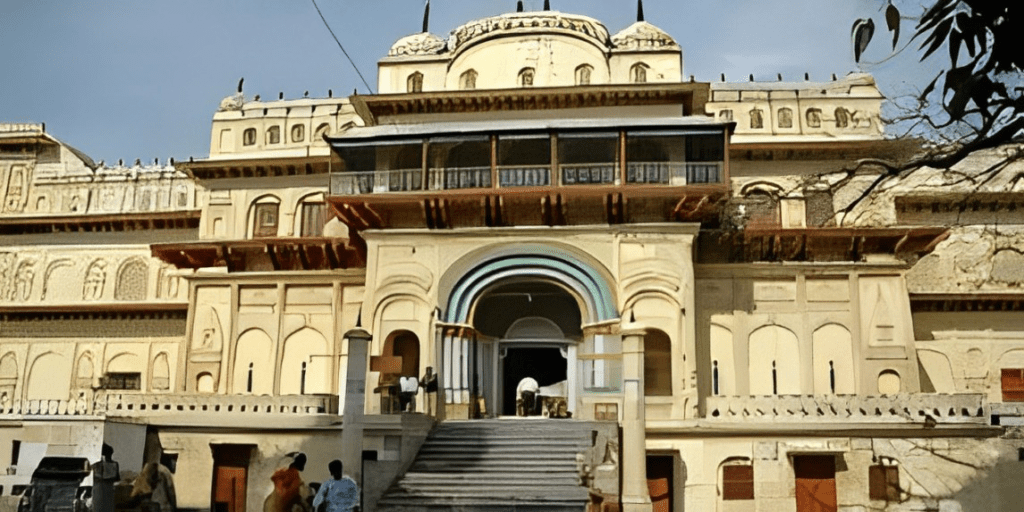
Source: Optima Travels
Nestled near the sacred Ram Janmabhoomi in Ayodhya, the Kanak Bhawan, also known as the Golden Palace, is a captivating temple dedicated to Lord Rama and his consort, Goddess Sita.
Stepping inside this architectural gem is like taking a journey through time, witnessing the enduring love story of these revered Hindu deities.
The temple’s name, Kanak Bhawan, aptly translates to “Golden Palace,” hinting at the grandeur it once held. While the original structure might have been opulent, the current building reflects the dedication of Vrish Bhanu Kunwari, who oversaw its reconstruction in a stunning Bundelkhand style.
As you enter the sanctum sanctorum, also known as the Garbagriha, your gaze falls upon three captivating idols of Rama, Sita, and Lakshmana, all adorned with golden crowns and sheltered beneath a gleaming silver ceiling.
Legend attributes this palace to Kaikeyi, Rama’s stepmother, who supposedly gifted it to the couple.
Over the centuries, Kanak Bhawan has undergone several transformations. While the exact details of its origin remain shrouded in mystery, historical accounts suggest it might have been refurbished during the reign of Vikramaditya.
Today, the Sri Vrishbhan Dharma Setu Trust Private Limited meticulously manages the temple, ensuring its legacy continues to inspire devotees.
A visit to Kanak Bhawan is not just a pilgrimage; it’s an experience that transports you to a bygone era, where love, devotion, and architectural brilliance intertwined to create a lasting testament to the divine couple, Rama and Sita.
A hidden gem often overshadowed by more prominent sites, Kanak Bhawan unveils a different side of Ayodhya. Built in the 18th century as a royal residence, this opulent palace showcases intricate Awadhi architecture.
Its expansive gardens, ornate fountains, and serene courtyards offer a glimpse into the city’s royal past.
Sita ki Rasoi: Famous Places in Ayodhya
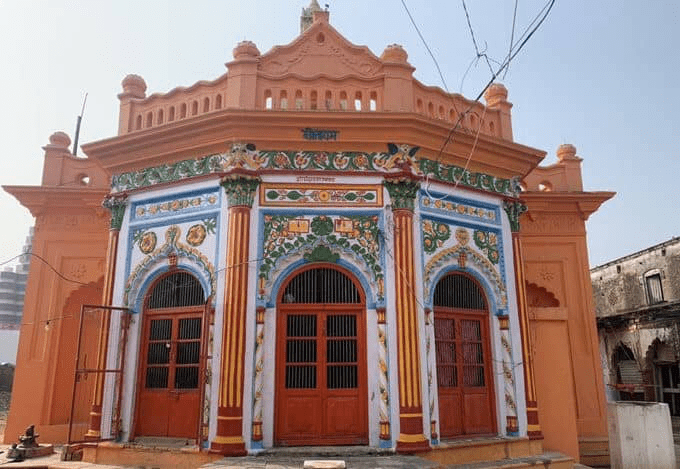
Source: Rishikesh Day Tour
Nestled near the sacred Ram Janmabhoomi in Ayodhya lies Sita ki Rasoi, a place steeped in myth and devotion.
This revered site, literally translating to “Sita’s Kitchen,” is not merely a historical landmark but a functioning temple that embodies the enduring legacy of the Hindu goddess Sita.
While the exact origin remains shrouded in legend, many believe this ancient kitchen was once used by Sita herself.
Today, the site serves as a temple, housing symbolic kitchenware like rolling pins and grinding stones, a testament to its culinary past.
Stepping inside the temple, you’ll find intricately adorned idols of Lord Rama, Lakshmana, Bharata, and Shatrughna, along with their respective consorts – Sita, Urmila, Mandvi, and Srutakirti.
This depiction reflects the traditional custom where newly married daughters-in-law would prepare meals for the entire family.
Beyond its historical significance, Sita ki Rasoi holds a special place in the hearts of devotees. Sita, also revered as the goddess Annapurna, is associated with nourishment and sustenance.
Honoring this association, the temple upholds the tradition of offering free meals to visitors, upholding the spirit of generosity and community.
Additionally, visitors can choose to contribute donations, reflecting the spirit of giving and compassion.
Sita ki Rasoi transcends its physical form, standing as a symbol of devotion, tradition, and selflessness.
It’s a place where history whispers through its walls, and the spirit of giving continues to shine brightly, offering a glimpse into the enduring legacy of Sita and the values she embodies.
Choti Chawni: Famous Places in Ayodhya

Source: Facebook
Standing tall amidst the spiritual landscape of Ayodhya, Choti Chawni, also known as Valmiki Bhawan or Maniramdas Chawni, is a sight to behold.
This magnificent structure, crafted entirely from pristine white marble, offers a unique blend of history, architecture, and spiritual significance.
Choti Chawni’s true wonder lies in its intricate cave complex. Housing a total of 34 caves, it showcases the rich tapestry of religious diversity that has flourished in Ayodhya over the centuries.
The southern section features 12 Buddhist caves, while the central section houses 17 Hindu caves. Completing the architectural symphony are 5 Jain caves located in the north.
Stepping inside these caves is like embarking on a journey through time.
Each cave, adorned with intricate carvings and sculptures, tells a story of its own, reflecting the artistic sensibilities and beliefs of the community it belonged to.
Adding to the splendor is the majestic Kailasha Temple, intricately carved within the caves. Its presence further emphasizes the architectural brilliance and spiritual significance of Choti Chawni.
Whether you’re a history buff, an architecture enthusiast, or simply seeking a serene escape, Choti Chawni offers something for everyone.
Its captivating beauty and diverse heritage make it a must-visit destination in Ayodhya.
Tulsi Smarak Bhawan: Famous Places in Ayodhya
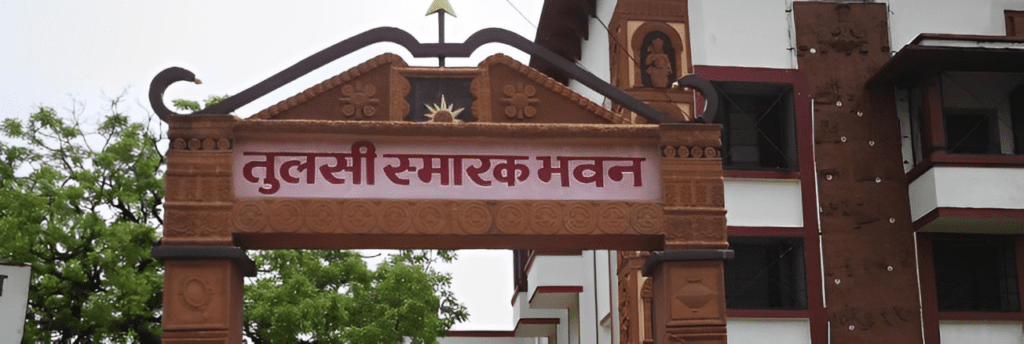
A Celebration of Goswami Tulsidas and the Ramayana
Standing tall in Ayodhya, the Tulsi Smarak Bhawan is a monument dedicated to the revered 16th-century saint-poet, Goswami Tulsidas.
Built in 1969, the Bhawan is believed to be the very place where Tulsidas composed the epic Ramacharitmanas, a timeless retelling of the Ramayana.
Beyond its historical significance, the Tulsi Smarak Bhawan offers a multifaceted experience for visitors. Here’s what you can expect:
- A Treasure Trove of Knowledge: The Bhawan houses a vast library, a repository of rich literature not just related to Tulsidas’ works, but also encompassing various facets of Ayodhya’s cultural and spiritual heritage.
- A Center for Learning: The Ayodhya Research Sansthan, located within the Bhawan, delves deep into the essence of Ayodhya’s literary, cultural, and spiritual legacy. This research center not only conducts in-depth studies but also engages visitors through daily recitals of the Ramkatha, a captivating narration of the Ramayana.
- A Visual Journey: Immerse yourself in the world of Ramayana through captivating artworks and crafts displayed within the Bhawan. These artistic expressions bring the epic tale to life, offering a visual treat for visitors.
- A Museum of History: Established in 1988, the Ram Katha Sanghralaya, housed within the Bhawan, is a museum dedicated to Lord Rama. It boasts a collection of artifacts, data, and information that sheds light on the life and times of Lord Rama.
- A Place of Celebration: The Bhawan comes alive during Tulsi Jayanti, a festival celebrated with great fervor on the seventh day of the Shravan month. Special prayers, devotional songs, and sermons fill the air, creating a vibrant and spiritual atmosphere.
The Tulsi Smarak Bhawan transcends its physical form, standing as a testament to the enduring legacy of Goswami Tulsidas and the timeless tale of the Ramayana.
It invites both devotees and curious minds to explore the rich tapestry of Ayodhya’s heritage, offering a unique blend of history, spirituality, and artistic expression.
Raja Mandir: Famous Places in Ayodhya
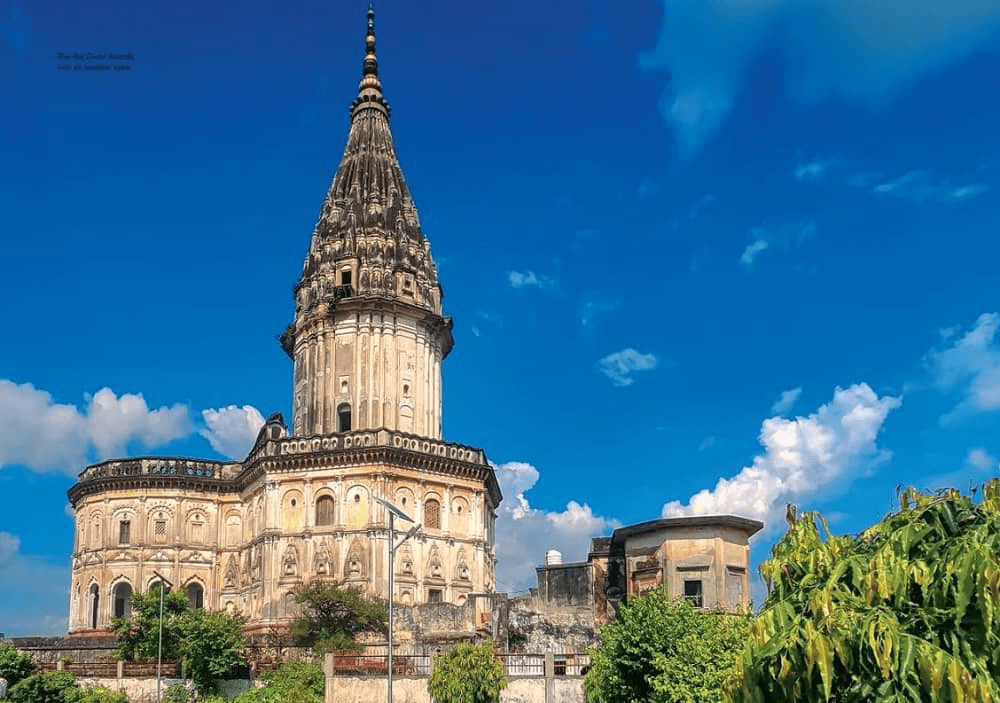
Source: Rishikesh-Day-Tour
Unveiling Legends on the Banks of the Sarayu
Standing majestically on the banks of the Sarayu River (also known as the Ghaggar) in Faizabad, the Raja Mandir is more than just a temple; it’s a portal to a bygone era, steeped in myths and legends.
While its exact origin remains shrouded in mystery, the intricately carved idols housed within its walls, adorned with shimmering silk and precious jewels, whisper tales of a glorious past.
Once associated primarily with Lord Rama, the revered king of Ayodhya, the Raja Mandir has evolved into a more inclusive space, showcasing a diverse collection of Hindu deities.
Each idol, meticulously crafted, speaks volumes about the artistic brilliance of traditional Hindu architecture.
The temple’s riverside location adds to its allure. The shimmering reflection of the Raja Mandir in the tranquil waters of the Sarayu creates a truly mesmerizing spectacle.
Devotees, drawn by the spiritual significance of the site, flock to the temple throughout the year. Many believe that a dip in the holy waters of the Sarayu can cleanse their souls, offering them a sense of peace and renewal.
Whether you’re a pilgrim seeking spiritual solace, a history buff delving into the past, or simply an admirer of architectural beauty, the Raja Mandir offers a unique and captivating experience.
It’s a place where myths and legends come alive, leaving a lasting impression on all who visit.
Ram Katha Park: Famous Places in Ayodhya
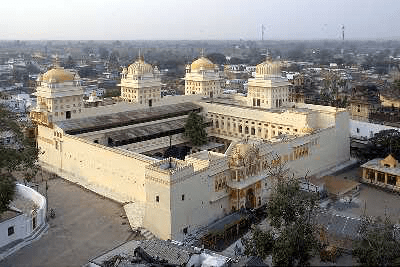
Source: Holidify
A Haven of Recreation and Culture in Ayodhya
Nestled amidst the vibrant city of Ayodhya lies Ram Katha Park, a haven of tranquility and cultural expression.
Sprawling across a vast area, this beautiful park offers a welcome respite from the urban bustle, catering to diverse interests and age groups.
When not adorned for special events, the park transforms into a playground for children, filled with laughter and joyous energy.
Lush green lawns and open spaces provide ample room for them to run, play, and explore. Adults, too, find solace in the park’s serene atmosphere, using it as a leisure garden to unwind and soak in the fresh air.
Beyond its recreational purpose, Ram Katha Park is a vibrant platform for cultural activities. The spacious amphitheaters becomes a stage for various events, hosting devotional programs, cultural performances, and religious activities.
Whether it’s captivating dance recitals, soulful poetry readings, or captivating katha recitations, the park pulsates with artistic expression.
Furthermore, the park embraces inclusivity, promoting both cultural and pop events. It welcomes national and international artists, fostering a diverse and enriching experience for visitors.
This openness has established the park as a popular destination, offering a refreshing alternative to the city’s often crowded and congested venues.
A visit to Ram Katha Park is like stepping into a world of diverse experiences. Whether seeking a moment of peace, an opportunity to witness cultural performances, or simply a space for children to play, this park caters to all.
It stands as a testament to Ayodhya’s rich cultural tapestry, where tradition and modern expressions find a harmonious blend.
Dashrath Bhavan: Famous Places in Ayodhya
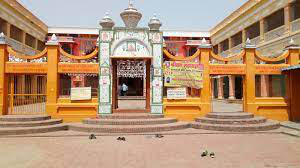
Source: TripNight
Whispers of a Royal Past in Ayodhya
Nestled in the heart of Ayodhya, in the Ramkot area of Faizabad, lies Dashrath Bhavan. This enchanting structure, though not a grand palace, holds immense significance as the erstwhile residence of King Dashrath, the father of Lord Rama.
Stepping into Dashrath Bhavan is like stepping back in time, allowing visitors to experience a glimpse of the royal life during Rama’s era.
The Bhavan boasts an ornately decorated entranceway, adorned with captivating murals that hint at the grandeur of the past.
Stepping inside, the air is often filled with the melodious sounds of saffron-clad monks chanting hymns, singing devotional songs, and performing traditional dances within the royal walls, keeping the memory of the king and his legacy alive.
While not as expansive as a typical palace, Dashrath Bhavan attracts a steady stream of visitors throughout the year, particularly during major Hindu festivals like Ram Vivah (wedding of Rama), Karthik Mela, Diwali, Ram Navami, and Shravan Mela.
These festive occasions witness the Bhavan come alive with vibrant celebrations, offering devotees a chance to connect with the legendary king and the epic Ramayana.
Whether you’re a history buff seeking a glimpse into Ayodhya’s royal past or a devotee seeking a spiritual connection to Lord Rama, Dashrath Bhavan offers a unique and captivating experience.
It stands as a testament to the enduring legacy of the royal family and continues to be a cherished landmark in the city.
Ghats of Saryu River: Famous Places in Ayodhya
The lifeblood of Ayodhya, the Saryu River flows like a thread of serenity through the city. Bathing in its holy waters or simply soaking in the panoramic views from the ghats is a soul-rejuvenating experience.
Witness the vibrant dawn rituals and the magical evening reflections of golden lamps on the water’s surface.
Guptar Ghat: Famous Places in Ayodhya
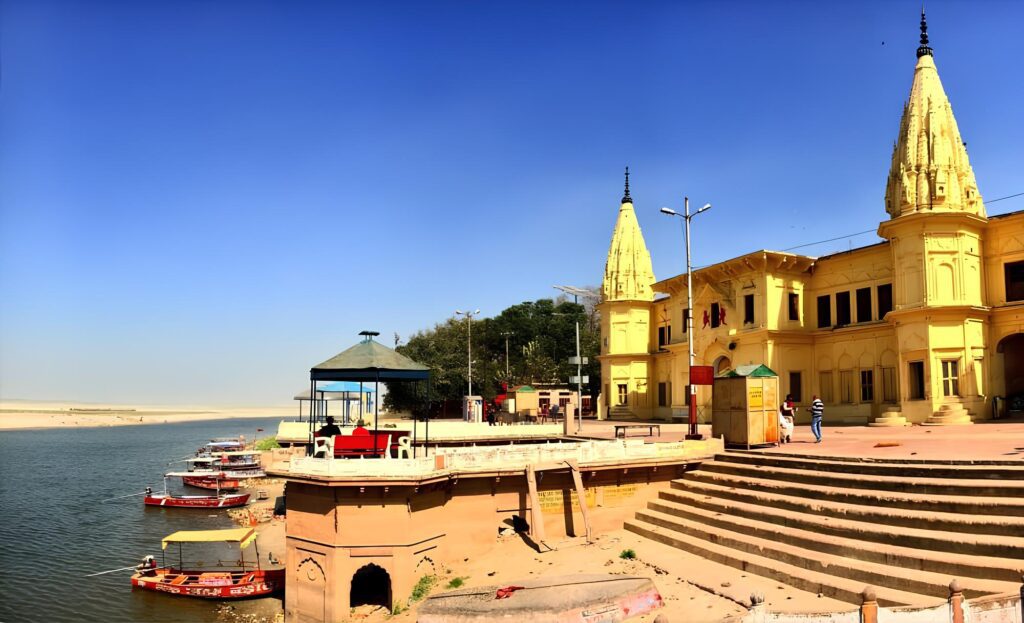
Source: Rishikesh-Day-Tour
A Sacred Gateway on the Banks of the Sarayu
On the sacred banks of the Sarayu River, also known as the Ghaggar, in Faizabad near Ayodhya lies Guptar Ghat, a revered place steeped in legend and spiritual significance.
This holy site, once a neighbor to the colonial Company Gardens (now known as the Gupta Ghat Van), holds a special place in the hearts of Hindu devotees.
Guptar Ghat’s most profound claim to fame lies in the belief that it was here that Lord Rama, the seventh avatar of Lord Vishnu, performed his ‘Jal Samadhi.’
This sacred act translates to “water burial,” signifying his departure from the earthly realm and his return to his celestial abode, Vaikuntha.
Beyond its profound spiritual significance, Guptar Ghat offers a visually captivating experience. A majestic flight of steps leads down to the holy river, inviting devotees to partake in rituals and immerse themselves in the sacred waters.
The ghat is adorned with several notable temples, including the Sita-Ram Temple, the Chakrahari Shrine, and the Narsingh Temple.
These structures, along with the ghat itself, underwent significant renovation in the 1800s and continue to be maintained by the Uttar Pradesh government. This ensures the preservation of this sacred space for generations to come.
Today, Guptar Ghat stands as a testament to faith, tradition, and the enduring legacy of Lord Rama. It’s a place where devotees come to seek solace, offer prayers, and connect with the divine.
Whether you’re a pilgrim seeking spiritual fulfillment or a traveler exploring the cultural tapestry of Ayodhya, Guptar Ghat offers a unique and captivating experience.
Mani Parvat: Famous Places in Ayodhya
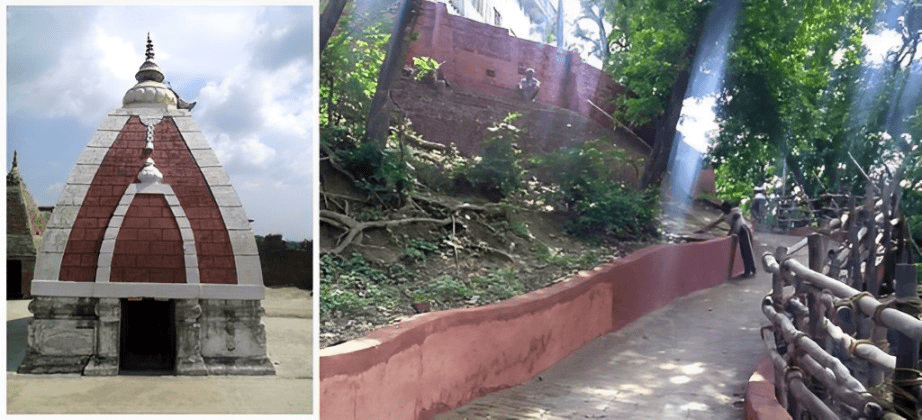
Source: Book Ayodhya Tour
Nestled near Ayodhya’s Kami Ganj area, Mani Parbat rises a humble 65 feet above sea level, offering more than just a scenic vista.
This small hillock is a microcosm of Ayodhya’s rich religious tapestry, housing historical and spiritual treasures from different faiths.
Atop the hill, you’ll be rewarded with breathtaking views of the city below. But the true journey begins as you explore the various sites nestled on its slopes.
One of the most significant is a stupa, believed to have been erected by the renowned Emperor Ashoka. This ancient structure stands as a testament to the Buddhist influence that has graced this land.
Additionally, a Buddhist monastery whispers tales of a bygone era, offering a glimpse into the religious landscape of Ayodhya’s past.
Standing alongside these Buddhist landmarks are several Hindu shrines, highlighting the city’s diverse religious heritage.
Interestingly, the hillock finds itself situated near another mound called Sugriv Parbat, further adding to the historical and spiritual significance of the area.
At the foot of Mani Parbat lies an Islamic mausoleum, a serene reminder of the peaceful coexistence of faiths that has been a hallmark of Ayodhya.
While the city vibrates with the presence of Lord Rama, Mani Parbat showcases the unique blend of religious influences that have shaped Ayodhya over the centuries.
It’s a place where history whispers through the stones, and the spirit of inclusivity shines through its diverse landmarks.
So, when you visit Ayodhya, be sure to add Mani Parbat to your itinerary, for it offers a powerful experience that transcends religious boundaries.
Gulab Bari: Famous Places in Ayodhya
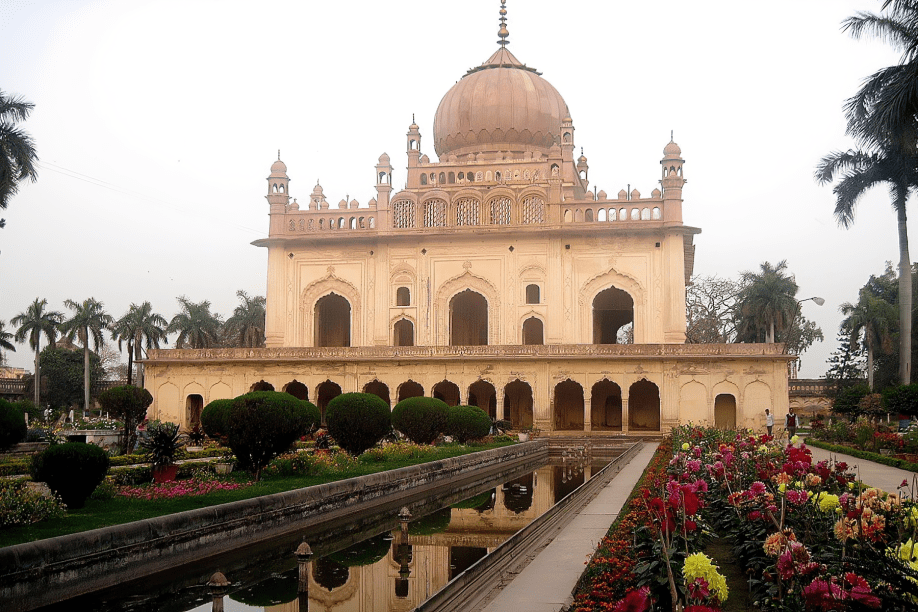
Source: Trawell.in
Nestled amidst the bustling streets of Faizabad, near Ayodhya, lies the Gulab Bari, a fragrant oasis known as the “Garden of Roses.”
This captivating complex, built in the 18th century, transcends its role as a tomb, offering a glimpse into the architectural legacy of the Nawabs and the beauty of nature.
Serving as the final resting place of Nawab Shuja-ud-Daula, the third Nawab of Faizabad (Oudh or Awadh), and his parents, Gulab Bari boasts an architectural style that exemplifies the grandeur of the Nawabi era.
Intricate designs and elegant structures stand in harmony with the lush gardens, creating a sense of serenity amidst the historical significance.
Beyond its architectural marvel, Gulab Bari truly lives up to its name. The sprawling gardens boast a vibrant collection of rose varieties, their colorful blooms adding a touch of fragrance and beauty to the landscape.
Cascading fountains further enhance the tranquil atmosphere, inviting visitors to pause and immerse themselves in the peaceful ambiance.
Recognized for its historical and cultural significance, Gulab Bari has been declared a monument of national importance under the “Ancient Monuments and Archaeological Sites and Remains Act.”
This recognition ensures the preservation of this unique space, allowing future generations to experience its charm and historical significance.
Whether seeking a moment of peace amidst the vibrant city or yearning to delve into a bygone era, the Gulab Bari offers a unique and captivating experience.
It’s a place where history whispers through the architectural details, nature’s beauty unfolds in a riot of colors, and the fragrance of roses fills the air, creating a lasting impression on every visitor.
Step into a fragrant sanctuary at Gulab Bari, the Rose Garden. This sprawling garden with over 100 varieties of roses offers a visual and olfactory feast.
Stroll through the vibrant blooms, lose yourself in the intoxicating aroma, and let the tranquility wash over you.
Embark on a mini-trek to Mani Parvat, a hillock overlooking the city. Legends associate it with Lord Rama’s archery practice.
The climb offers breathtaking views of Ayodhya’s sacred landscape and a sense of peaceful solitude amidst the bustling city.
Awadhi Cuisine: Famous Places in Ayodhya
A Traveler’s Delight
No trip to Ayodhya is complete without indulging in its delectable Awadhi cuisine.
From melt-in-your-mouth kebabs like Galouti and Kakori to the rich Rogan Josh and flavorful Awadhi Biryani, the city’s culinary scene is a tapestry of aromatic spices and lip-smacking flavors.
Ram Ki Paidi: Famous Places in Ayodhya
Take a walk down memory lane at Ram Ki Paidi, a series of ghats on the Saryu River. Legend has it that Lord Rama and Sita spent their evenings here.
Today, it’s a bustling cultural hub with artists showcasing their talents, street vendors offering tempting local delights, and pilgrims seeking blessings.
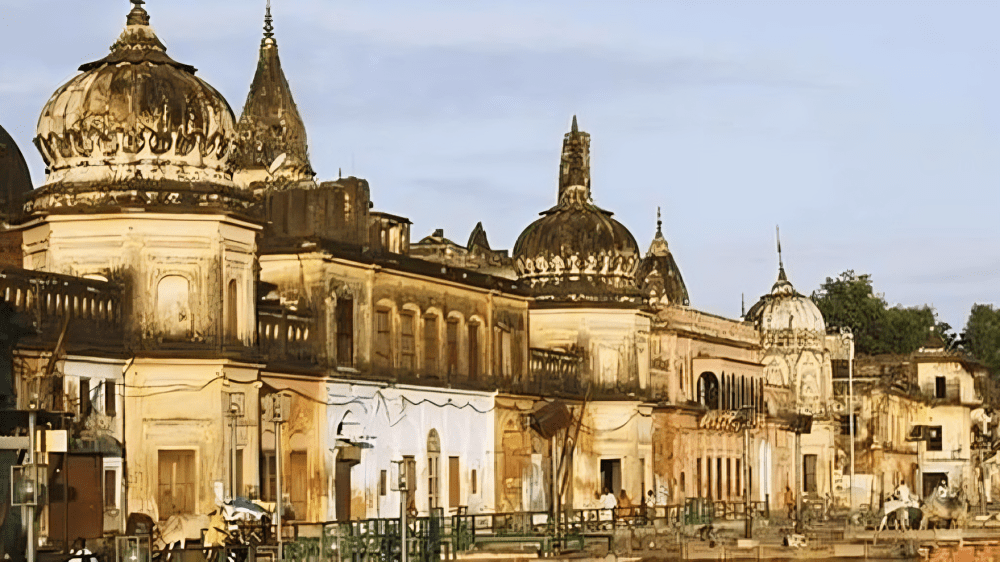
Ayodhya Light and Sound Show: Famous Places in Ayodhya
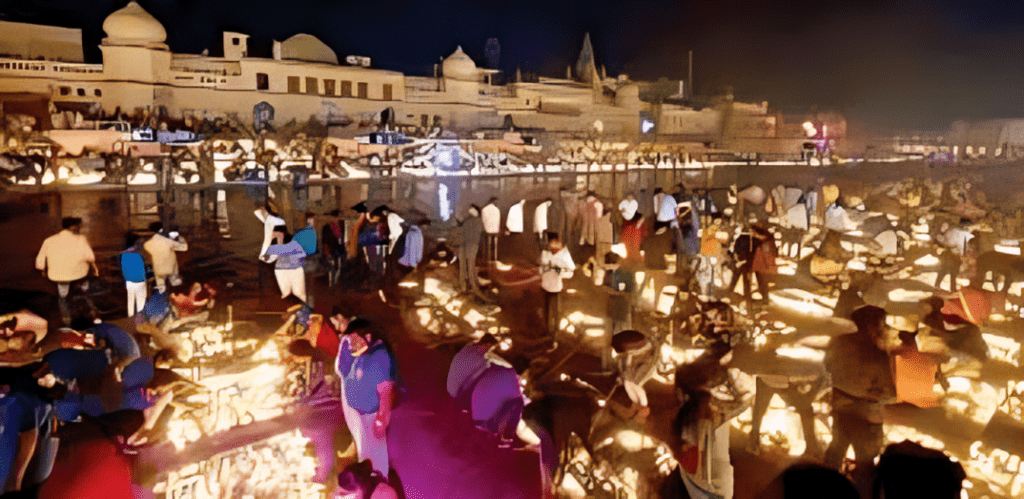
Source: Navhind Times
Witness history come alive at the Ayodhya Light and Sound Show. As dusk paints the Saryu River gold, Ayodhya awakens to a different kind of magic.
The legendary Ram Ki Paidi, where tales of Rama and Sita echo across millennia, becomes the stage for a mesmerizing spectacle.
Laser beams dance across the ancient ghats, weaving vibrant tapestries of light and shadow. The majestic Ram Janmabhoomi site bathes in ethereal hues, its architectural details magnified to a breathtaking scale.
The air vibrates with an ethereal soundtrack, narrating the epic Ramayana through pulsating rhythms and poignant melodies.
Witness Lord Rama’s triumphant return to Ayodhya, the poignant scenes of exile, and the epic battle with Ravana – all come alive in a kaleidoscope of color and sound.
It’s an immersive experience that transcends time and space, transporting you into the heart of the epic saga.
Beyond the visual grandeur, the show whispers deeper messages of devotion, resilience, and the triumph of good over evil.
It leaves you with a renewed appreciation for Ayodhya’s rich heritage and the timeless power of the Ramayana.
So, if you’re ever in Ayodhya, don’t miss the magic of the Light and Sound Show. It’s a must-see spectacle that will leave you awestruck and forever etched in the tapestry of your Ayodhya memories.
FAQs: Famous Places in Ayodhya
1). Beyond temples, what unique experiences does Ayodhya offer?
Ayodhya isn’t just about temples, though they’re phenomenal. Get your feet wet with a boat ride on the Saryu River, soaking in the city’s reflection and the gentle breeze. Immerse yourself in the aroma of roses at Gulab Bari, a fragrant paradise.
For a dose of history, explore the ancient ruins of Mani Parvat or delve into the life of Tulsidas at his dedicated museum.
2). I’m on a tight budget. Can I still enjoy Ayodhya?
Absolutely. While Ayodhya has luxurious options, budget travelers can thrive here. Sample the city’s soul at the vibrant Ram Ki Paidi ghat, where artists and local food vendors mingle.
Explore the bustling bazaars for souvenirs and delicious street eats. Consider homestays or budget hotels for a more authentic experience.
3). Is Ayodhya safe for solo travelers, especially women?
Ayodhya generally boasts a safe atmosphere, and solo travelers, including women, can navigate the city comfortably. Take common precautions like avoiding venturing out alone at night and sticking to well-lit areas.
Local people are usually friendly and helpful, so don’t hesitate to ask for directions or recommendations.
4). I’m interested in experiencing Awadhi culture. What should I do?
Immerse yourself in the sounds and sights! Witness the Ram Lila performances, intricate theatrical retellings of the Ramayana. Sample the diverse Awadhi cuisine, from melt-in-your-mouth kebabs to aromatic biryanis.
Attend devotional music sessions at temples or soak in the atmosphere of evening arti rituals on the ghats. Learn a few basic Hindi phrases to connect with locals and deepen your experience.
5). I’m not religious. Will I still enjoy Ayodhya?
Absolutely. Ayodhya’s charm extends beyond its religious significance. The city’s rich history, vibrant culture, and stunning natural beauty offer something for everyone.
Explore the architectural marvels like Kanak Bhawan, take a peaceful stroll through Gulab Bari, or experience the magic of the Saryu River. Ayodhya welcomes all with open arms, regardless of their beliefs.
ALSO READ-
https://topupdates.info/celebrity-workout-routines-10-star-approved-plans/
https://topupdates.info/latest-bollywood-movies/
https://topupdates.info/filmyzilla-bollywood/
https://topupdates.info/best-elastane-stretch-mid-waist-shorties/
https://topupdates.info/womens-plus-size-chest-print-t-shirt/
https://topupdates.info/amazing-desert-air-cooler-for-home/
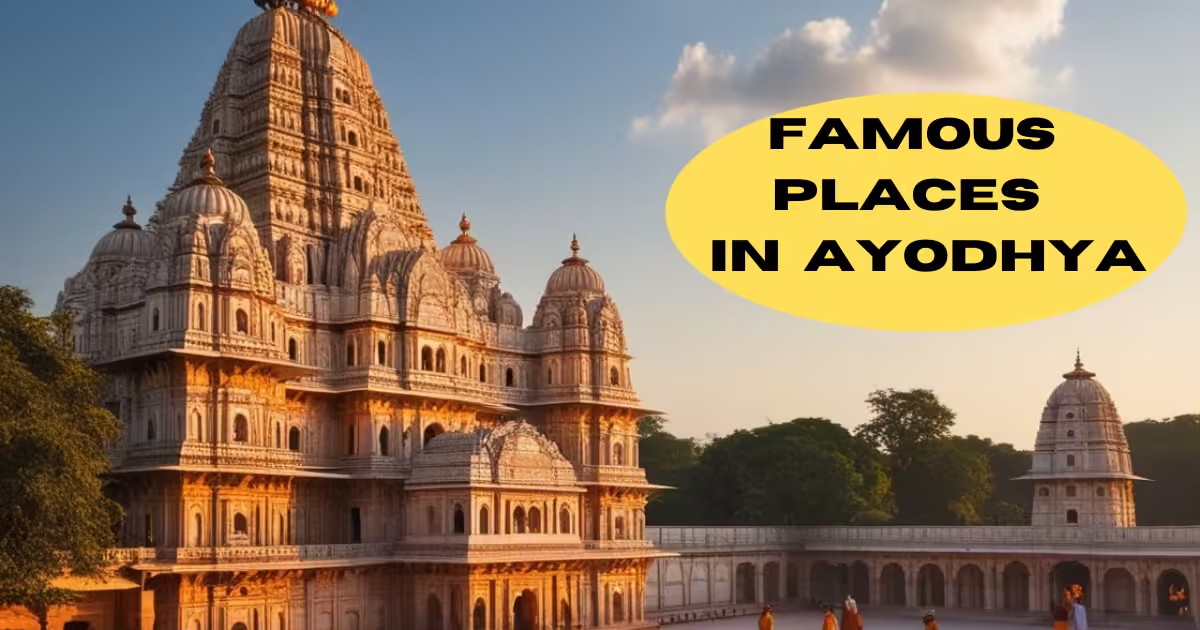
4 thoughts on “Top 10 Must-Visit Famous Places in Ayodhya”